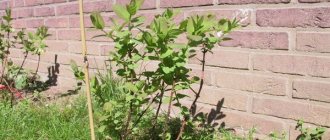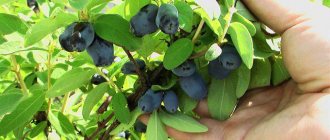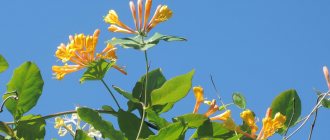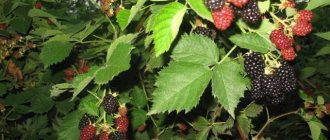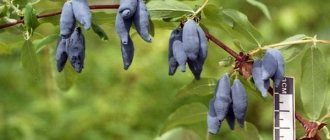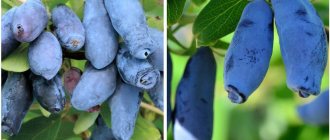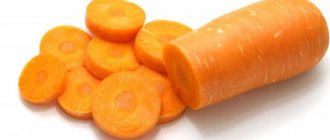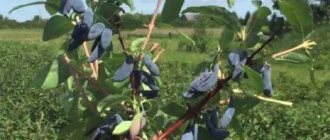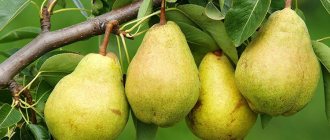The honeysuckle variety Bakcharsky Giant is the largest-fruited representative of the crop. The yield is not very high, but many gardeners love to grow the plant precisely because of its large berries, calling them the blue miracle. The harvest of the Bakcharsky Giant is tasty and juicy, the plant does not require care, is resistant to many diseases, the bush actively bears fruit for 15 years or more.
Honeysuckle variety "Bakcharsky Giant"
variety “Bakcharsky Giant” can withstand frosts up to 35 degrees
A distinctive feature of honeysuckle “Bakcharsky Giant” is its large berries
Description of the variety
This variety is famous for its medium ripening period and tasty large fruits. The variety has a strong bush that reaches a height of 2 m. The crown is round with a slightly sharp tip. The branches are smooth and thick, reaching 0.5 m in length. The crown is heavily shrouded in large green leaves with a matte surface.
Honeysuckle Bakcharsky Giant bears large berries, the weight of one is about 1.8 g, the length is 5 cm. Some fruits can reach a weight of 2.5 g. The berries are cylindrical in shape with a waxy layer. Blue skin. Sometimes you can see small voids underneath.
The pulp is juicy, the seeds are not felt. The taste is spicy with a twist - sourness. A tasting meeting was held, at which scientists gave the Bakcharsky Giant berries a score of 4.8 points out of 5.0. This indicator deserves respect and pride for the variety of domestic selection.
Honeysuckle can be eaten fresh, or the fruits can be frozen. Various preserves are prepared from the berries, such as compotes, juices, jams, liqueurs and wines.
Productivity
The first harvest from this honeysuckle variety can be obtained in the 3rd or 4th year after planting. The first berries delight the gardener at the beginning of summer, so the honeysuckle harvest appears much earlier than strawberries or raspberries.
From one bush you can collect about 2-3 kg of fruit. If the care and climate conditions were favorable, then you can harvest up to 4.5 kg of crop. Gardeners receive from 8 to 15 tons of fruits from 1 hectare.
Pollinators
Cross-pollination is necessary for the honeysuckle variety Bakcharsky Velikan, since the flowers themselves are not pollinated. In order for the harvest to be worthy, other types of honeysuckle should be planted on the site next to the Giant. The best varieties for pollinating the Bakcharsky Giant:
- In memory of Gidzyuk.
- Bakchar's pride.
- Nymph.
- Amphora.
- Azure.
Honeysuckle pests
This variety is practically disease free. But still, he has enough enemies. For example, aphids, roseate leaf rollers, moths, honeysuckle moths. It is better to save the Bakchar giant from each of them using preventive measures.
In the spring, even before the berries ripen, you need to spray the bush with insecticides. To prevent the solution from being washed off quickly, green soap is added to its composition, which in itself is an antiseptic and “fixes” insecticides on the surface of the leaves and shoots of honeysuckle.
Tips: It will be useful to thin out the crown not only to make it easier to harvest, but it also contributes to the health of the plant.
Fungal and viral diseases bypass the Bakchar giant honeysuckle. There is no need to worry about preventative and treatment measures, but pests can visit and multiply if appropriate measures are not taken.
For preventative purposes, spraying with insecticidal preparations in early spring helps against aphids, roseate moths, moths and other leaf-eating insects. For better adhesion of the solution, grated soap is added to the water.
At the beginning of spring, during the budding period, Aktara or Eleksar solution helps against aphids. “Inta-Vir”, “Decis” are induced from the rose leaf roller.
All drugs are used in solution, according to the instructions, and only at the beginning of the season, before the flowers appear or after harvesting.
As a folk remedy, you can use an infusion of tomato or potato tops.
With simple and easy care, a bush with beautiful blue berries will reward you with a wonderful harvest.
Advantages and disadvantages of the variety
Reviews from gardeners claim that there are many more good aspects of the culture than negative ones. Let's look at it in more detail.
Benefits of honeysuckle Bakcharsky Giant:
- regular fruiting;
- large and tasty berries;
- spicy taste of fruits;
- the harvest can be collected quickly and easily, because the branches are located at a distance from each other;
- excellent resistance to fungal diseases;
- high frost resistance, in winter honeysuckle can withstand temperatures of about -35 degrees Celsius;
- fruits can be transported from one place to another, the berries do not spoil, and the taste does not deteriorate.
Disadvantages of growing honeysuckle Bakcharsky Giant:
- crumbling of ripened berries. They must be removed immediately after full maturity, otherwise the entire harvest will be on the ground. Experienced gardeners quickly solve this problem - they spread a film onto which the fruits fall;
- low yield. Due to the fact that the berries are large, the bush cannot bear large quantities of them.
Watch a review of the honeysuckle variety “Bakcharsky Giant” in the video below:
Pollinators of honeysuckle Bakhchisarai giant
Honeysuckle is a cross-pollinated fruit shrub. To obtain stable yields, gardeners recommend planting pollinating varieties nearby. It is optimal to place 2-3 additional types of honeysuckle; the bushes are placed in groups on the site. Can be planted as a hedge. It is recommended to choose from the following varieties:
- Delight;
- Silginka;
- The Giant's Daughter;
- Enchantress;
- Yugan, etc.
We recommend that you familiarize yourself with Barberry Red Pillar
To improve the quality of pollination of buds, it is recommended to spray the bushes before flowering with a special solution. You will need to dissolve granulated sugar (2 tbsp) and liquid natural honey (2 tbsp) in settled water (10 l).
In cloudy and rainy weather or precipitation, fruit bushes are sprayed with compounds that increase the rate of ovary formation. The solution is prepared from the preparation Zircon (1 ampoule), water (10 l), and Cytovit preparation (2 ampoules). The buds are sprayed with the composition.
Rules for growing honeysuckle Bakcharsky Giant
It is not difficult to grow this variety of honeysuckle. However, in order for the plant to adapt successfully, you should adhere to the basic rules of planting a crop.
Landing dates
Planting can be done both in spring and autumn. The shrub forms ovaries too quickly, but slowly takes root in the ground.
In order for the development of honeysuckle Bakcharsky Giant to proceed safely, it is better to plant the seedling in the autumn season (September or October). Over the fall and winter, the plant will strengthen, take root and become stronger, and in early spring it will begin to delight the gardener with ovaries and rapidly growing green mass.
Selecting a location
Honeysuckle Bakcharsky Giant does not cope with strong winds, so the plant should be planted next to various fences. Honeysuckle does not withstand strong humidity; groundwater should be located no higher than 1.5 m to the surface of the water.
It is better to plant shrubs at higher elevations, since cold air and water accumulate in low-lying areas.
Selection of seedlings
An experienced gardener knows that when choosing a seedling, attention must be paid to the number of leaves the plant has. An excellent specimen that will take root on the site without any problems, will bring a rich harvest, and has 4-5 leaves. Undoubtedly, seedlings should be purchased only from trusted sellers.
Soil and lighting
The variety loves sunny areas, but the lower branches should be located in the shade. The crop should be planted in a group with other pollinating varieties. Thus, the crown will be in the sun, and the basal branches will be shaded.
Honeysuckle is not particularly picky about the soil, but it produces a large amount of harvest on fertile soil; it is better to choose loam. The soil should be neutral; if the soil is too acidic, then add lime to the hole.
Step-by-step planting diagram
Before planting, the seedlings are moistened with a growth stimulant, after which this algorithm is followed:
- Clear the area of excess debris and organic matter.
- Sprinkle humus, rotted manure, peat or compost onto the soil surface. Calculation per 1 sq. m 10 kg of product.
- Dig up the area.
- Prepare recesses 40x40 cm.
- Place drainage at the bottom, add 50 g of superphosphate and potassium salt into the recess.
- Spread the roots of the plant, place them in the soil so that the root collar is above the ground.
- Fill the holes with soil and compact them a little.
- Water the plants with water (5 liters per bush).
Do not forget to leave a distance of 1.5-2 m between seedlings, since the honeysuckle crown is wide and the root system is large.
Reproduction
The Bakcharsky Giant variety can be propagated in several ways:
- By layering. At the beginning of summer, you should dig up the soil around the plant, just do it very carefully so that the root system is not damaged. Bend a couple of lower branches to the ground, sprinkle with soil, and secure with wire. After 1 year, the branches will take root and can be separated from the bush.
- By cuttings. At the end of spring, cut off part of the 1st shoot with 3 buds. The size is about 0.1-0.15 m. Soak the seedling in a growth product and place it in a pot with soil. Create an artificial greenhouse using a plastic bottle.
- Bones. This is the longest and most difficult process of growing honeysuckle. Collect seeds from overripe berries of plants, plant them in containers, cover them with snow and wait for spring days. With the onset of warmth, cover the pots with film and wait for the sprouts to emerge. Before planting directly, treat the seeds.
Planting and care
The selection variety Bakcharsky Giant is a honeysuckle that requires proper care. In order for the bush to take off and begin to grow on the site, you need to follow several basic planting rules. It is recommended to plant bakchara in winter, but no later than mid-October. During this time, the sprout will have time to take root and gain strength before wintering. In spring, the culture wakes up early, in early March. Heavy floods after the snow melts saturate the plant with moisture and beneficial microelements, which gives an additional leap in development.
After purchasing a seedling, the roots are immersed in water with any growth activator. After this, you can prepare the area:
- the planting site is cleared of weeds;
- the soil is fertilized with humus, peat, rotted manure or compost (10 kg/m²);
- the plot with fertilizers is dug up;
- prepare a hole for planting measuring 40x40 cm;
- drainage is made at the bottom of the hole and 50 g of potassium salt and superphosphate are added;
- the roots of the plant are straightened and carefully placed in the recess, then covered tightly with earth;
- After the procedure, the bush is watered with 10 liters of water.
When planting several specimens of honeysuckle at the same time, a distance of 2-2.5 m should be maintained. When moving to another place, it is recommended to dig up the shoot along with the soil. This will help minimize damage to the roots, and the honeysuckle will recover faster.
We recommend that you read: Gooseberry diseases and their treatment
In addition to dividing the bush into parts, there are 3 more methods of propagation:
- Seeds. This method is the most labor-intensive, which is why it is used infrequently. Planting material is collected from ripe berries and sown in a container with soil. With the onset of winter, they are covered with a thick layer of snow until the weather warms up. In the spring they are protected with film to create a greenhouse effect and wait for the first shoots to appear.
- By cuttings. At the end of May, after the appearance of young shoots, branches 10-15 cm long with 3 buds are cut from the bush. They are treated with a solution to stimulate growth, planted in the ground and covered with a plastic bottle.
- By layering. At the end of June, the ground under the bush is loosened, while several lower stems are dug in and secured with rope. The next season, the rooted shoots can be replanted.
Gardeners note that only 1/3 of the seedlings are accepted for cuttings. This must be taken into account when preparing planting material.
When choosing a place for a shrub, you must keep in mind that it does not like excessive humidity and does not tolerate windy weather well. Therefore, honeysuckle is not recommended to be placed in open areas, drafts and lowlands. The plant loves sunlight, but the root system should be in the shade. A good planting option would be in the vicinity of low trees and shrubs. So the top of the crop will be bathed in sunlight, and the lower part will be shaded.
The Bakchar variety is not picky about soil, but yield indicators will be better on loose soil mixed with clay. The composition of the soil should be fertile, with a low level of alkali. In the case of acidic soil, the hole is treated with ash or dolomite flour before planting.
An adult plant is watered once every 5 days. The optimal rate is 10-12 liters of water per bush. If there is excess moisture, honeysuckle will rot, and if there is too little moisture, the berries will grow hard and bitter. Therefore, it is recommended to adjust the frequency of watering depending on weather conditions. The crop needs more moisture during the period of flowering and ripening of berries, and in the fall, irrigation, on the contrary, is minimized. After watering, the soil under the bush needs to be loosened.
We recommend that you read All about raspberries
Bakchar honeysuckle is fed 3 times a year. At the end of March, apply nitrogen-based fertilizers, such as ammonium nitrate. The optimal dosage is 15 g per 1 bush. The next stage is the restoration of the plant after fruiting. To do this, you need to apply fertilizer based on phosphorus and potassium. The most common remedy is nitrophos. For 1 specimen, at least 25 g of fertilizer diluted in a bucket of water is required. In order for honeysuckle to survive the winter well, it is watered with an organic solution, which consists of 10 liters of water and 2-2.5 liters of manure.
Anti-aging pruning is carried out for plants older than 3 years. First of all, remove dry and broken branches, then shoots that grow inward or close to the ground. For normal development, 10-15 healthy branches should remain on the bush. However, it should not be thick. The size and taste of the fruit depends on the amount of light penetrating deep into the honeysuckle.
The variety is characterized by high resistance to most diseases. However, it may be susceptible to pest invasion: aphids, mites or caterpillars. To avoid this, it is recommended to treat the bushes with protective drugs in the spring before flowering.
Gardeners recommend the following:
- Inta-Vir;
- Mauritius;
- Elexar;
- Confidor.
Honeysuckle care
The culture is undemanding in terms of care, but the high-quality appearance of the shrub guarantees great fruiting.
We recommend reading the article on how to care for honeysuckle in the autumn.
Watering
The bush is watered 1-2 times a week, one root needs 8-10 liters of water. If there is not enough of it, then the berries become bitter. With excessive watering, the root system rots. Therefore, you need to focus on the climatic conditions of your region.
If the weather is dry, increase the amount of watering; if it is rainy, reduce it. In autumn, the shrub is practically not watered. After irrigation, the soil must be loosened without damaging the roots.
Top dressing
Honeysuckle of this variety is fertilized three times. In the spring, products containing nitrogen are used, as the bush grows green mass. You can use ammonium nitrate, 15 g of product per plant.
The substance nitrophoska (25 g per 5 liters of water) will help restore fruiting of honeysuckle. If you don’t have it, then you can use phosphorus-potassium fertilizers. Organic fertilizers are added in the fall. To do this, manure is mixed with water in a ratio of 1:4. One plant needs 10 liters of mixture.
Trimming
Young seedlings do not need pruning; this event will not help them, but on the contrary will harm them. The first pruning is carried out in the 3rd year after planting the bush.
Broken, old and dried branches need to be removed. Sloping shoots should also be trimmed. There should be from 10 to 15 branches left on the plant, it all depends on the age of the bush. The more sunlight penetrates into the middle of the honeysuckle, the larger the fruits will become.
If the honeysuckle Bakcharsky Giant is already an old bush, then a rejuvenating procedure can be carried out; for this, all branches are removed at a level of 0.3-0.35 m.
Harvesting
The Bakcharsky Giant honeysuckle berries fall off very quickly, so they must be collected immediately after ripening. They come off the stalk well, the bush is wide - harvesting will not be difficult.
Preparing for winter
The variety’s homeland is the territory of Siberia; on its land, the shrub can withstand frosts of -50 degrees Celsius. There is no need to cover the plant. It should not be planted in the southern regions, because too warm a winter season can cause the plant to bloom again, which is useless.
Diseases and pests
The Bakchar Giant is not susceptible to disease. But the plant suffers from attacks by various pests. Therefore, in the spring season it is necessary to carry out preventive measures in the form of spraying. You can use the following drugs: Mavrik, Confidor and Inta-Vir.
Selection of seedlings when purchasing
What does it take for a plant to be healthy and produce good yields? Here are a few points that are important to consider when planting and caring for Bakcharsky giant honeysuckle:
- choosing a suitable location,
- healthy seedlings,
- watering,
- applying fertilizer,
- loosening the soil.
Landing location
It should be sunny and protected from winds and drafts.
After you have chosen a place for the bush, you need to prepare a planting hole. It should be at least 0.5 m deep and 0.5-0.6 m wide. Drainage is laid on the bottom, the top is covered with a mixture of humus and peat, then there is a layer of soil mixed with mineral fertilizers (200 g).
You can even make a small mound so that the roots of the plant are evenly distributed over its surface. Then you need to pour water into the hole, and do not bury it until all the water is absorbed. And only then sprinkle the plant, but do not cover the root collar.
Recommendations: If you plan to plant several bushes of honeysuckle Bakcharsky giant, then the distance between them should not be less than 1.5 m.
The best time to plant this variety is early autumn. Then the honeysuckle has time to take root before the cold weather, and the acclimatization period is less painful.
Honeysuckle care
Watering. Honeysuckle loves water, but you cannot overdo it, otherwise the roots of the plant will begin to rot. During planting, 10 to 15 liters should be poured under the bush in several doses. Subsequently, the bush should be watered abundantly, especially during the growing season. In autumn, it is recommended to reduce watering to a minimum.
Feeding. What fertilizers does the honeysuckle variety Bakcharsky giant need? In spring - nitrogen fertilizers. They need to be applied before the leaves appear, preferably as soon as the buds begin to swell. In summer - phosphorus-potassium preparations. In autumn - organic.
Loosening. Honeysuckle loves when there is free access to the roots of air. Therefore, it is imperative to loosen the tree trunk space after each watering. It is advisable to mulch the soil after this so that the moisture does not evaporate.
Wintering. The honeysuckle variety Bakcharsky giant tolerates frost well, and therefore no special preparation for the winter period is necessary.
Seedlings are planted both in spring and autumn. Experienced gardeners recommend, for better survival, to plant the Bakchar giant in the first or second decade of September. This way, the plant will have time to acclimatize before severe frosts, sprout permanent roots and survive the winter more easily. Planting in the spring is less tolerated.
Purchasing high-quality planting material is the key to a future excellent harvest, so you need to buy it from trusted companies or in specialized stores. The market is not the best place to purchase seedlings.
When choosing planting material, special attention must be paid to the condition of the roots and shoots. You need to cull all bushes that look depressed, with broken branches, rotten or dried out root systems. It should have at least 5-6 healthy, undamaged leaves.
Planting holes are prepared at intervals of 2 m from each other, taking into account the fact that over time the crown of the plant will grow. The depth of the hole is dug using the bayonet of a shovel, the diameter of the hole is about 30-40 cm.
A layer of drainage is poured into the planting hole. This could be broken brick, expanded clay, or crushed stone. Soil mixed with fertilizers is poured on top, and water is poured near a bucket.
Before planting, for better survival, it is recommended to dip honeysuckle roots in a growth stimulator, root or simply in clay mash. When installed in the planting hole, all the roots are straightened so that they do not look up.
Carefully filling the soil with soil, lightly compact the soil, making sure that there are no voids. The growth point should be flush with the ground surface or slightly buried, no more than 2-3 cm.
After compacting the soil, the seedling is watered again and the tree trunk circle is mulched. This can be peat chips, old sawdust, chopped straw. Honeysuckle is not pruned during planting.
In dry and warm autumn, it is recommended to water newly planted plants. Every week you should pour out a bucket of warm water. In rainy times, the procedure should be stopped.
In the first spring after planting, the bush may bloom, even a small harvest is possible, but real fruiting begins at 4-5 years of age if all the rules of agricultural technology are observed.
2-3 years after planting in a permanent place, the plant is fed for the first time, since until this time the bush has enough nutrients if the hole has been well filled with fertilizers. During this period, honeysuckle grows a powerful root system.
During the summer season, three-year-olds are fed:
- the first is in the phase of the beginning of bud swelling, at the beginning of the season. These should be nitrogen fertilizers that help increase the growth of young shoots. 30 g of ammonium nitrate or 20 g of urea are added scatteredly. During the dry period, you can add a nutrient mixture in a bucket of water and combine watering and fertilizing,
- to lay a larger number of fruit buds, the second feeding is carried out in July, after the final harvest. Honeysuckle will respond well to the procedure of watering with a liquid infusion of mullein, a bucket for each bush. If this is not possible, then prepare a solution at the rate of 25-30 g of nitroammophoska per bucket of water. The procedure should be combined with weeding and loosening the soil around the plant,
- the third, final feeding is carried out before winter, to increase the bush’s endurance in frosty winters. A tablespoon of potassium salt and double superphosphate is scattered on each square meter of the tree trunk circle, followed by embedding into the soil.
In conclusion, before the winter period, the tree trunk circle should be mulched with humus, compost, old sawdust, and peat chips.
Feeding is carried out for both young plants and adult bushes every 2-3 years.
Watering honeysuckle
It is necessary to water the bushes as the soil around the plant dries out, but without much fanaticism, since the bushes do not like stagnation of water at the roots. They may rot and the seedling will get sick.
Honeysuckle Bakcharsky giant is especially demanding of watering during the growing season. By autumn, the amount of water poured under the bush is reduced, and in case of heavy autumn rainfall it is reduced to a minimum.
When planting a seedling, at least a bucket of water is poured into the hole in small portions. Subsequently, the young bush is watered as needed, combining the procedure with removing weeds and loosening the tree trunk.
There is no need to protect plants from cold winds, because honeysuckle is one of the most frost-resistant crops, which practically does not freeze and tolerates winter frosts well.
Landing. Scheme for planting bushes on personal plots: 1.5x2 m. Since honeysuckle is not a self-fertile crop, it is necessary to plant at least three, and preferably five, different varieties nearby for good cross-pollination.
Honeysuckle is very unpretentious. It grows well in all types of soil. Prefers neutral ones, but tolerates slightly acidic ones as long as they are rich in organic matter. On heavy clay, as well as poor peat and sandy soils, planting holes are filled not with “native” soil, but with a specially prepared planting mixture, which is made up in equal proportions of the top fertile layer, river sand and rotted manure.
Fertilizers. For the first two years, young plants do not need to be fertilized, as they have received all the necessary nutrition for their growth and development when planted.
After the third year, fertilizers begin to be applied. The first feeding is carried out in the spring, at the beginning of flowering. During this period, honeysuckle needs nitrogen fertilizers. It is best to feed with a carbamide solution, which dissolves well in water.
In summer, you can feed with some mineral complex or add 20 g of ammonium nitrate, 10 g of urea, and 50 g of superphosphate per plant. You should not dig up the ground under the bush, since the root system of honeysuckle is superficial, and digging can damage it. Nitrogen fertilizers are highly soluble in water, so they are diluted in 10 liters and applied along with irrigation. Before this, superphosphate is evenly scattered in the tree trunk circle, shallowly embedding it in the ground using a small hoe or a “paw” with teeth.
In the fall, potassium and phosphorus fertilizers are applied, which help honeysuckle to better prepare for winter and help increase its winter hardiness. It is best to apply double superphosphate (3 matchboxes) and potassium sulfate (2 boxes) under one plant.
Diseases and pests. In garden plots, honeysuckle practically does not get sick. Pests also rarely attack it. Occasionally, aphids may settle on young shoots. False scale insects may appear on woody trunks, and leaf beetle caterpillars can damage leaves.
For prevention, it is recommended to treat honeysuckle bushes with 0.2% Actellik or 0.2% Rogor in the spring before the buds open. This will be quite enough to rid your honeysuckle of uninvited guests.
Trimming. In the first 6-7 years, bushes do not form. They are limited to removing dry branches that have fallen to the ground.
Large-fruited honeysuckle will take root well in a dry corner of the garden. In the first 2–3 years, the shrub grows slowly, and then actively grows.
It is best to plant honeysuckle in a sunny area without drafts or wind. Good lighting guarantees you a good harvest and rapid ripening of the berries.
Despite the fact that this plant is absolutely not picky about the soil, it should be noted that it does not tolerate excessive moisture. The most favorable time for planting is early autumn, in which case the shrub will have time to take root and strengthen before frost.
When choosing seedlings, you need to pay attention to the number of leaves. A good seedling, which will certainly take root and bear fruit well, should have 4–5 leaves. Naturally, it is preferable to purchase seedlings from trusted sellers.
Even an inexperienced gardener can grow honeysuckle “Bakcharsky giant”, because planting and caring for it is not difficult if you follow simple rules.
Due to the fact that the plant is unpretentious, it is enough to weed the weeds in a timely manner and provide moderate watering. It is advisable to loosen the soil around the bush after the water procedure.
- choosing a suitable location;
- healthy seedlings;
- watering;
- applying fertilizer;
- loosening the soil.
Selection of seedlings
Reviews from gardeners about the Bakchar Giant
★★★★★
Olesya, 46 years old, lawyer, Omsk. I heard from a friend that she grows honeysuckle like this in her dacha.
I think why don't I try it. I planted two bushes. I noticed that the number of berries depends on the planting location. In open areas, the bush is blown out and produces little fruit. In the 3rd year I collected 0.8 kg of berries. The second bush grows near the currants, so it is protected from the wind. There are no frozen branches on it, and the harvest was pleasing - 2 kg of berries! The difference is significant. Now I’m thinking that I need to make a fence for the first seedling, because I want to get the same tasty fruits from it.
★★★★★
Vladimir, 32 years old, psychologist, Moscow region. A couple of years ago I ordered the Bakcharsky Giant from the nursery.
The variety was packed in a bag, and the branch was lined with moss. I have already received the fruits, but small ones. The bush grows rather weakly, the shoots are too elongated. The name did not justify itself, because I expected much more from the bush. ★★★★★
Ivan, 66 years old, entrepreneur, Krasnodar. I understood one thing - my city is not suitable for this variety of honeysuckle at all.
In winter the bush began to bloom! This was a real surprise for me. After this, the plant was unable to produce a normal harvest in the summer. I must have made a mistake with the variety. And I really wanted to see big results. Hide
Add your review
The Bakcharsky Giant variety is a godsend for many summer residents living in the Siberian region. The culture is cold-resistant, intended for cultivation in cold regions. In order for the plant to produce a rich harvest, it is necessary to regularly care for it and follow all the rules of agricultural technology.
0
0
Copy link
Harvesting and transportation, keeping quality of berries
Harvesting begins when the skin of the fruit has acquired a dark, uniform color. According to reviews from gardeners, when picking berries, the disadvantage of a crumbling variety is used as an advantage: a film or cloth is spread under the bush, the plant is shaken, and all the ripe fruits are collected.
The Bakchar giant tolerates transportation if the berries are collected in a shallow container and in a thin layer. Honeysuckle fruits are thin-skinned with a delicate pulp structure, so even in the refrigerator the crop is not stored for a long time. Most of the harvest is processed - this is jam, jam or compote, frozen.
Honeysuckle is an unpretentious crop that is resistant to external negative manifestations. Its berries are healthy and tasty, and are often used for medicinal purposes.
Productivity
With proper care during the growing process, Bakchar honeysuckle produces a good harvest. Depending on the specific region and conditions, on average 2-2.5 kg of berries can be removed from one bush, the maximum recorded is 4.5 kg.
Important! The fruits can be eaten fresh, frozen, processed into wine, juice, jelly, compote, jam. Also, the Bakchar giant honeysuckle tolerates transportation well.

